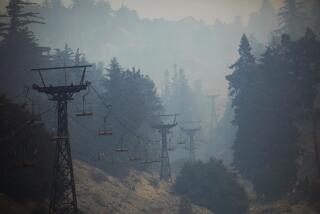Gas Emissions Close Sierra Campground : Geology: Carbon dioxide level near Mammoth Mountain rises to that found at active volcanoes. But experts say there are no indications of an imminent eruption.
Federal scientists monitoring volcanic activity under Mammoth Mountain report that they have measured an increase in carbon dioxide emissions near the mountain, prompting the closure of a high country campground.
The apparent rise in gas emissions to 1,200 metric tons a day--as high as at many active volcanoes, and two to three times higher than at Mammoth last year--and an increase in earthquakes this year have led the U.S. Geological Survey to pay closer scrutiny to the Mammoth Lakes region.
There are no indications of an impending eruption, experts emphasized.
*
Reports of carbon dioxide killing trees at Mammoth Mountain surfaced last year. Scientists traced the phenomenon to an apparent intrusion of lava under the mountain in 1989, when a swarm of earthquakes rocked the area.
But as the rate of emissions and the area of dead trees have expanded, scientists reporting in the Smithsonian’s Bulletin of the Global Volcanism Network have observed that it is possible an intrusion of magma is continuing beneath the surface.
David P. Hill, the USGS scientist in charge of monitoring the Long Valley caldera, an ancient volcanic crater 18 miles wide near Mammoth Lakes, said this week that the heavy snowpack could have contributed to the higher concentrations of carbon dioxide.
He said new measurements of the odorless gas will be taken as soon as the snow melts, which is expected in about a month. If the higher rate of emissions is reconfirmed, it will be evidence of continuing lava intrusions, he said.
A draft of a scientific journal article on the emissions says the gas reached unsafe concentrations recently in campground restrooms, tents, a small cabin and an underground utility vault near Horseshoe Lake in the high country above the town of Mammoth Lakes.
In two cases, the concentrations were at lethal levels, the draft says.
Fred Richter, a ranger with the U.S. Forest Service, said Friday that the Horseshoe Lake campground would remain closed this summer because of health concerns. It could reopen if new measurements find that the gas emissions have abated.
*
C. Dan Miller, a scientist at the Cascade Volcano Observatory in Vancouver, Wash., recently declared Mammoth Mountain and Oregon’s Newberry Crater the two most likely next sites for volcanic eruptions in the contiguous 48 states.
A new report took note of two moderate earthquakes of magnitude 4.4 and 4.3--followed by aftershocks--that occurred near Mammoth Mountain on March 4. “This March 4 sequence was roughly four times more energetic than the combined energy for all earthquakes occurring within the caldera during 1994,” the report said.
The report also said deformation of the land surface within the caldera has persisted since 1990.
The last eruptions in the highly volcanic Mammoth region were 200 to 500 years ago, and one of the greatest eruptions ever took place in the caldera about 700,000 years ago.
More to Read
Sign up for Essential California
The most important California stories and recommendations in your inbox every morning.
You may occasionally receive promotional content from the Los Angeles Times.










